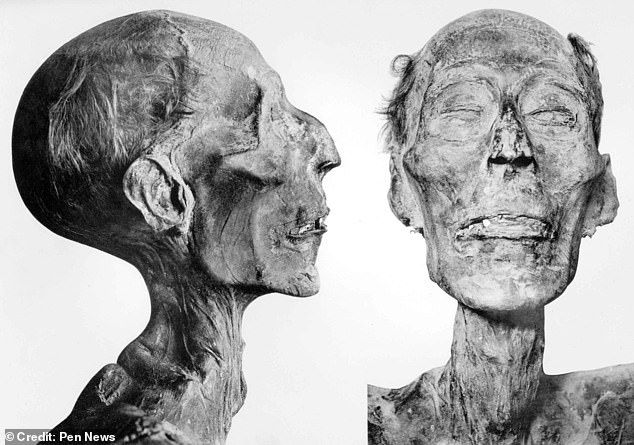
'WISE' FACE OF ANCIENT EGYPT'S MOST POWERFUL IS REVEALED
- READ MORE: Archaeologists uncover 'City of the Dead' in Egypt
The 'wise' face of ancient Egypt's most powerful pharaoh has been revealed, showing him moments before death.
Ramesses II, who reigned in the 13th century BC, was the greatest ruler of the nation, known for his colossal statues and military exploits during his reign from 1279 to 1213BC.
Scientists used a 3D model of the king's skull, layering it with soft tissue and skin to recreate his look at the time of his death, around 90 years old.
The life-like image revealed a frail, elderly man with a weathered face - and some features were similar to the giant statues of Ramesses that still stand in Egypt.
Cicero Moraes, the Brazilian graphics expert behind the new recreation, said: 'In the present study we carried out a very broad analysis, comparing the reconstructed face with statues of Ramesses II.
'The objective was to understand to what extent the statues are reliable, as many imagine that compatibility would be good. 'But we saw that this is not the case – the statues indicate good compatibility with the shape of the nose and even, in some situations, with the shape of the face.'
The statues of Ramesses II have a more delicate forehead and lips and a chin that are more pronounced, making the features in the image 'insufficiently reliable.'
'We also analyzed anthropometric and DNA data from ancient Egyptian populations, and all paths seem to point to a population made up of many elements that are difficult to standardize,' said Moraes.
The team chose a skin color palette that has been seen in ancient Egyptian art as the true hue is unknown.
They also designed a grayscale version that showed the pharaoh's eyes closed to avoid making judgements about his complexion - but the team has suggested that criticism is soon to follow.
'There is always criticism about any work that is published on the internet, just look at the comments on the news and the debate on social networks,' Moraes said.
'I am in favor of freedom of expression. I myself have never blocked anyone on my networks for thinking differently than me or for insulting me.
'But I also have freedom of expression and I generally use it to clarify points and refute what is incoherent.'
The team also used information from a 1976 study of Ramesses' mummified remains, found in 1881, which restored tissues and created new bandages.
The study also determined that Ramesses II had a pronounced overbite, and his teeth were significantly worn.
The pharaoh also had poor dental and bone health, mainly due to an abscess, which would have caused him a lot of pain.
Despite the king having a long life, his muscles showed signs of memory loss, and he had very pronounced veins on his forehead,' Moraes and his team shared.
The team wanted to depict the aging alignments in the recreation of the king.
They compiled data from hundreds of modern Egyptians to reveal the likely thickness of the pharaoh's skin at different places across his skull.
Another technique was anatomical deformation, in which the face and skull of a living donor – who also had a pronounced overbite – was digitally altered to match the mummy's dimensions.
The end result interpolated these approaches, before ageing it appropriately, and adding subjective elements like clothing. It reveals what Moraes called a 'wise' face.
The result also appeared similar to a previous reconstruction from 2022, created by Sahar Saleem of Cairo University and Caroline Wilkinson of Liverpool John Moores University.
Different methods were used then, however, Moraes said he was pleased with the outcome.
The 2022 facial reconstruction was conducted by scientists from Egypt and England, who also used a 3D model of his skull.
They then reversed the ageing process, turning back the clock almost half a century to reveal his face at the height of his powers.
Saleem said the outcome had revealed a 'very handsome' ruler.
'My imagination of the face of Ramesses II was influenced by his mummy's face,' she continued.
'However, the facial reconstruction helped to put a living face on the mummy.
Read more 2024-06-28T15:26:03Z dg43tfdfdgfd